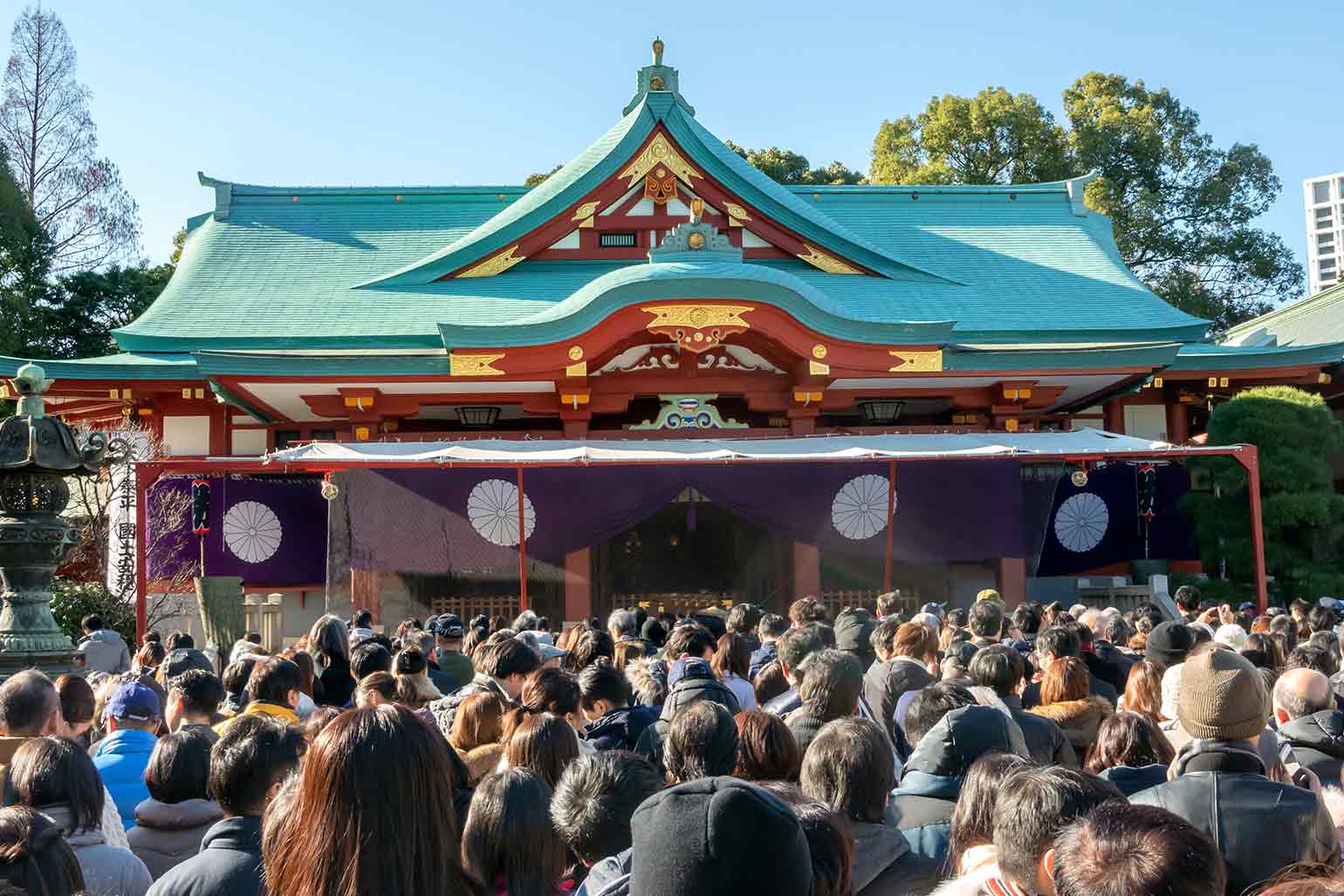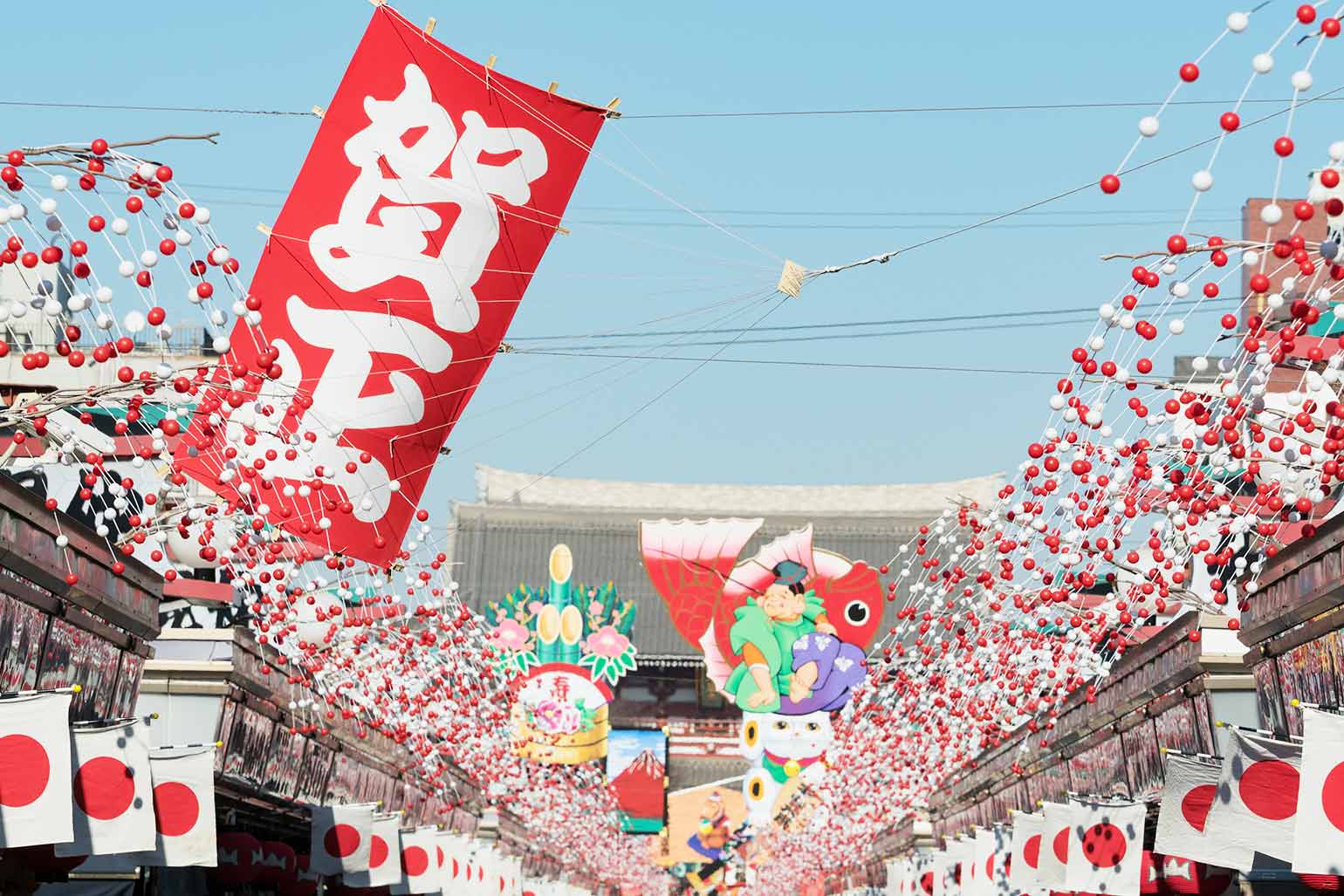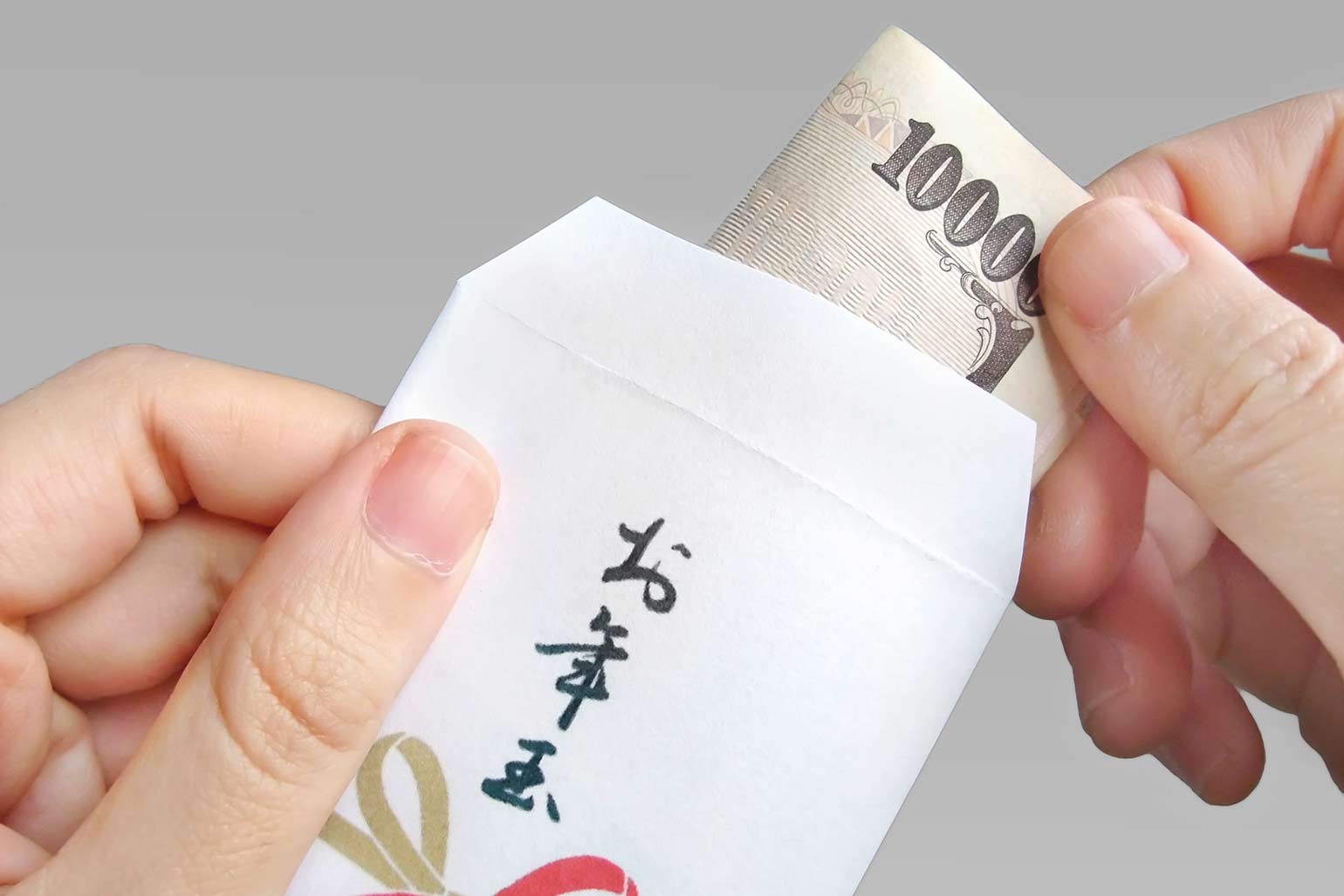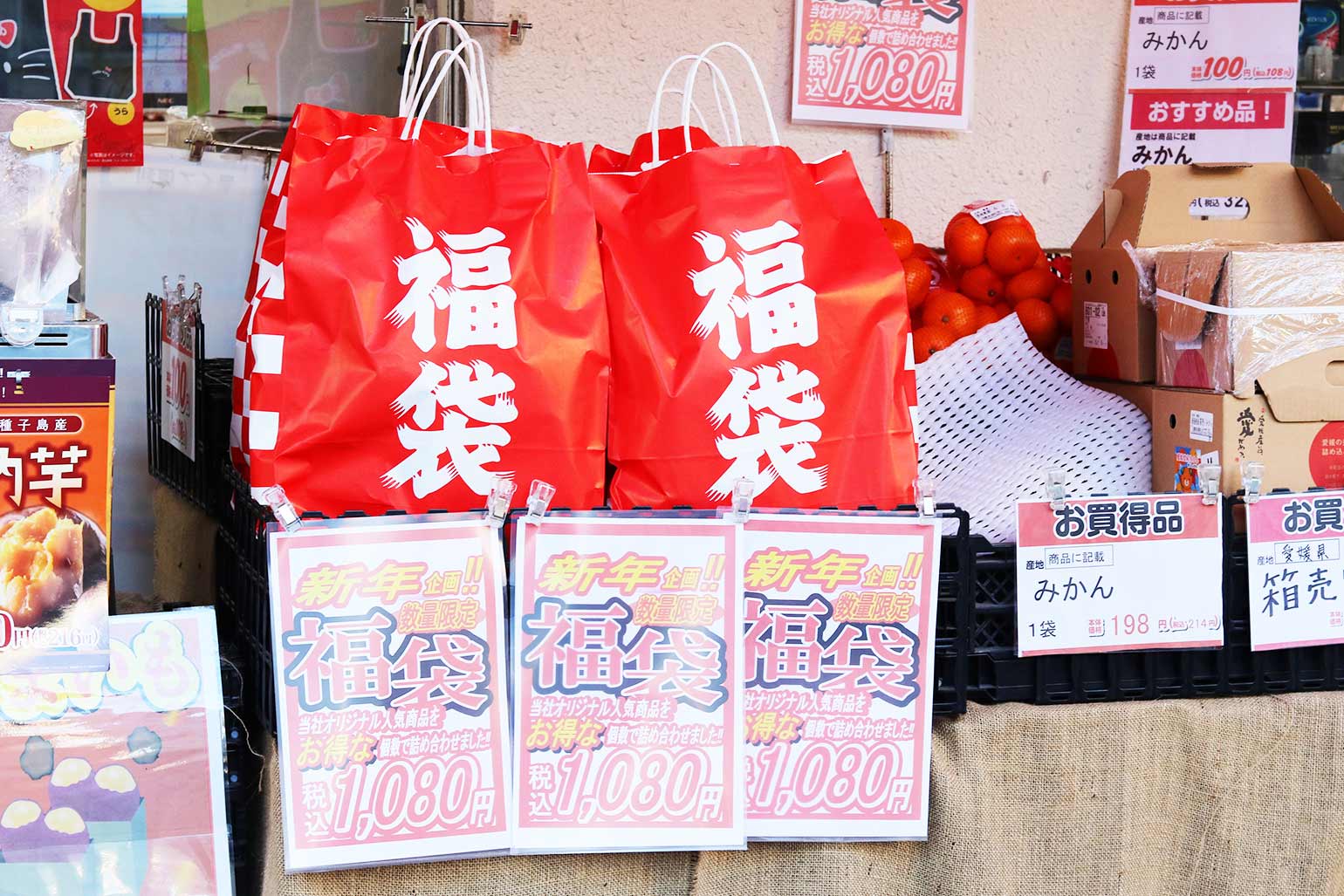In this article, we would like to share you some of the customs known as Japanese New Year’s traditions. We hope you will enjoy these customs, because all of them are all quite typical of Japan.
Hatsumoude (First visiting)

It is an event to visit shrines or temples to thank for the peace and blessings of the old year, and to pray for them in the new year as well. What makes it unique might be that it is a custom that has taken root even among many Japanese who are basically non-religious. It might be also interesting to note that it is well accepted by Japanese who have some other religion or belief. Originally, it is said that this event was held from the night of New Year’s Eve to the morning of New Year’s Day, when the family heads of each household would gather at a shrine enshrining the local deity (it’s called “Ujigami”) of the area where they lived and pray for the year. This eventually changed to a form of paying homage to shrines on New Year’s Day… Until around the end of the Edo period, it was done among the warrior class, court nobles, and large merchant families, but after the Meiji period, it became common among the general public. Since that time, it seems that people began to visit not only shrines enshrining local deities but also famous temples or shrines as one of the entertainment events during this time of year. Even today, the nature of this practice is well accepted, and “hatsumoude” to temples or shrines completely different from the area of residence has become commonplace. Various prayer’s items (omamori, hamaya, ema, kumade, etc.) for the aforementioned prayers are sold at temples or shrines, and purchasing them is part of the real pleasure of “Hatsumoude”. It might be said that this is the most lively event for temples and shrines throughout Japan.
Congratulatory words for New Year

During the New Year’s holiday in Japan, you can see many “wordings” to celebrate New Year coming” everywhere in town. Though Many of these “wordings” were not originally used exclusively to celebrate the New Year, they are now used to celebrate the New Year entirely. In Japanese, the “wordings” are especially called “賀詞(congratulatory words)”. There are quite a few different kinds of the “congratulatory words” to celebrate New Year. For example, single letters ones are “寿”, “福”, “賀”… Two letter words such as “賀正”, “迎春”, “新春”… Four letter words such as “謹賀新年”, “恭賀新年”, “慶賀新年”, etc… These might be the ones you will see most often. It is a well-known phrase used in advertisements, banners at commercial facilities, or New Year’s greeting cards during the New Year’s season. The basic meaning of each word is the same as “Happy New Year” used in English-speaking countries, but each word has a slightly different nuance. Therefore, when we use notations in commercial advertisements, banners, or New Year’s cards, we have to select appropriate ones. it is a very important manner. If used incorrectly, even though it is a “Congratulatory words for New Year”, it can be considered a lack of respect or consideration. For example, when the words used by a person of lower rank to a person of higher rank on working. Well, we will briefly give you a quick example of how to select ones appropriately. For example, a one or two- letter ones are generally considered inappropriate to be used by a junior to a superior, so a four-letters ones are probably used more often. Or, for superiors, it is better to use he somewhat standardized sentence-type words to avoid misunderstandings. There are many more “賀詞(congratulatory words)” in addition to the ones mentioned above. If you have a chance to see them, it might be interesting to investigate each significance.
O-Sechi-Cuisine

This is a traditional Japanese cuisine eaten during the New Year’s days. For more details, please refer to the article “O-Sechi Cuisine” on this website. It is said that Japan has a very rich and wide-ranging food culture. We guess it is thanks to the facts that Japanese people had always been very tolerant when coming to adopting foreign food culture. Today’s “Osechi” cuisine is also a good example of this. These days, many of “Osechi” cuisine are often a mixture of traditional Japanese cuisine and modern creations. Well, in fact, many Japanese people today (especially the younger generation) would prefer modernized Osechi cuisine to traditional Osechi cuisine… We think many of you from overseas will probably enjoy the wide variety of dishes. Of course, we would like you to try the traditional “Osechi” cuisine, which is unique to Japan, for the first time. Please continue to enjoy to the ever-changing Japanese “Osechi” cuisine.
Otoshidama(New Year’s money gift)

One of the typical Japanese New Year’s customs is called “Otoshidama. It refers to the custom of a senior person giving money to a lower person in celebration of the New Year, or the money itself. The definition of superior / lower in this case can be taken in a variety of ways, such as by age relationship or by work rank. Meanwhile, when a person of lower rank gives money or a gift to a person of higher rank, it is generally called “O-Nenga” in Japanese. Similar customs can be found in many Asian countries. In China, there is a custom of giving money to children as a kind of good luck charm since before modern times, and there is also a custom of giving money to each other regardless of superiority or lower, etc., right? The custom of New Year’s gifts just like “Otoshidama” in Japan seems to have existed during the Middle Ages. It was likened to welcoming the god of the year at New Year’s to ask for a bountiful harvest for the year, in other words, to share the god’s power. However, it was not money that was given at that time, and there were differences in gifts given/received depending on one’s status. For example, samurai families used swords. Townspeople and merchants gave ougi(fans) as gifts. It was actually only after the modern era (after World War II) that people started giving/receiving money itself. Combined with the recovery of the economy after the war and the momentum of the baby boom, the custom of giving “Otoshidama” spread rapidly among the general public in Japan. Well, this custom was originally intended to wish for the health of children or to express gratitude for relationships between people. It was also a way of communicating with relatives, acquaintances, etc. who live far away from each other and with whom we do not usually have much contact. However… In today’s Japan, it is more important to know how much is appropriate to give to a person of what age (mainly children), maybe…「( ̄▽ ̄;) And in recent years, it has become possible to send gifts in the form of electronic money or service points instead of cash, and the ” relationship style” seems to have changed considerably. Whether such changes are seen as good or bad is up to each individual, we can’t say for sure which is better either. It may be a very interesting custom in the sense that its appearance may change more and more in the future.
Nengajyo(New Year’s greeting card)

In Japan, there is a custom of sending greeting cards called “Nengajyo” to acquaintances or business associates to celebrate the New Year and express gratitude for their kindness and friendship during the past year. Christmas cards or New Year’s greeting cards in Western cultures are similar. It seems that similar customs exist in China, Korea, and other East Asian countries and regions. It is believed to have originally originated from the custom of New Year’s greetings among court nobles or other upper class people during the Nara~Heian periods. These were the New Year’s greetings delivered by visiting the recipient’s home in person, but these were soon replaced by the delivery of letters or gifts. After the shift to samurai society, it spread to the general public through the Edo period, when the culture of the townspeople flourished. The current Japanese postal system was started after the Meiji Restoration. With the introduction of postal postcards in 1873, it rapidly became common to send the custom of sending “Nengajyo” using postal postcard, which had previously been given to each other by letter. It seems to be around this time that the custom of “Nengajyo” as one of the annual year-end and New Year’s events took root in this country. After a period of rapid economic growth, combined with the trend of the times and the sophistication and diversification of printing technology, etc., the custom was very popular until around the early 2000s. However… as Internet technology became more common and cell phones became more widespread, the demand for such services of “Nengajyo” declined rapidly. The explosion of smartphones and social networking services in recent years has driven this trend. As with the custom of “Otoshidama” this may be also a custom that its meanings or ways are likely to change rapidly in the future.
Fukubukuro(lucky-dip bags)

“Fukubukuro” bags are the ones filled with various products and sealed for sale at the New Year’s first sales held at various commercial facilities including department stores, supermarkets, and restaurants, etc. Or, the sales form is also called “fukubukuro”. It is sometimes called “Otoshidama-bukuro” but here we would like to especially pay attention to how the term “fukubukuro” came to be used and what it means. Incidentally, although they bear the name “bukuro(bag)” their exterior is not limited to bag-like items, but can be boxes or other containers. The contents to be packaged include not only physical items, but also large items, intangible goods and services, and other items that are conceptually packaged. In most cases, these “bags” are sold at a bargain price (less than the total price of the contents of the bag), with the contents of the bag being hidden. In this way, the consumer can enjoy the pleasure of winning happiness and good luck. It is a kind of lottery, right? There are various theories as to when “fukubukuro” or “fukubukuro” sales forms began, but the most famous one, which can be called the true prototype of today’s “fukubukuro” appeared in the Edo period. It was the “Ebisu bag” sold at “Echigoya (now Mitsukoshi)” in Nihonbashi, which was known as one of the prominent kimono shops at the time. At the end of the year, they put the year’s excess fabric in bags and sold them at a low price, which was very well received. And later, similar sales began to be held at stores that sold other products, and it seems to have taken root in the general public… The idea of adding a twist to the fun of purchasing and doubling the enjoyment is still amazing, isn’t it? Of course, since the contents of the product are kept secret, the desired product is not always available, even if it is at a good price. As you can imagine, this sales form is not only an effective way for stores to attract customers, but also a way for them to dispose of their inventory. Therefore, the “fukubukuro” you buy is often filled with unsold or unpopular items… On the other hand, it can also be a chance to find a really great bargain or an unexpected encounter with a good product. Well, we guess the best part of a “fukubukuro” is to enjoy all those included. Now, how about you all try your luck?
※Ebisu : This deity is known as one of the seven gods of good fortune. He is generally depicted wearing a hunting robe and holding a fishing rod in his right hand and a sea bream on his left side. He is considered to be a guest or gatekeeper god related to the prosperity of business.

We have tried to summarize and shere you through these Japanese New Year’s Eve and New Year’s customs, but we are again reminded that customs are constantly changing as time goes by. The ways, the forms and meanings of the each custom used continue to change in a variety of aspects. Probably All of the changes are as it should be. Regarding these kinds of topics, all of us tend to focus on them that are fading away or disappearing. But the essential something of them might remain unchanged. Hmmm… we hope so.




_op.png)
_001.png)
_002.png)
_003.png)
_004.png)
_005.png)
_006.png)
_007.png)
_008.png)
